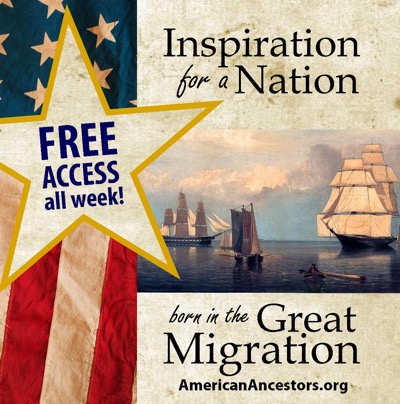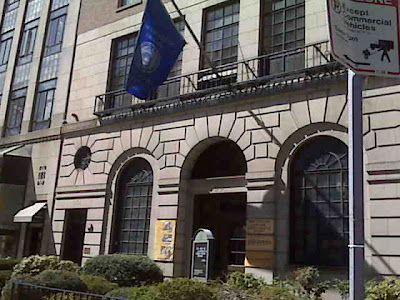Family Curator Visits NEHGS Spring Research Getaway 2009, Part 2: Consulting with the Experts
Mention “bricks” to a genealogist, and the image of a brick wall appears, followed by proposed strategies for climbing or demolishing the obstacle. But there is another use for bricks as well, one used with great care and skill by the staff at the New England Historic Genealogical Society. My experience at the 2009 Spring Getaway demonstrated the value of building a firm research foundation that can withstand any amount of weight as the evidence grows, brick upon brick.
Day One of the program, attendees met in the second floor education center the library. Conversation was already lively when I arrived and the room full of participants and friendly staff members. The program began with introductions from each member of the entire staff. I had stopped by briefly the day before and met a few people; it was helpful to see them again and put a name with a face. Staff members introduced themselves and explained their responsibilities at the Society or outlined their areas of expertise. From Event Coordinator, to Archivist, to Genealogist, to CEO, the entire staff were present to offer their assistance.
Then it was the participants’ turn to briefly introduce themselves and their goals for the session. Attendees came from New England, Tennessee, West Virginia, New York, Colorado, and California. Some participants had also attended the NEHGS research trip to Washington D.C. and were now ready to conduct more research at the Society Library.
Marie Daly, Library Director, opened the lecture series with a virtual tour of the library collections. The Library itself is spread out over six floors in an former bank building on Newbury Street in Boston’s Back Bay. The old teller’s windows are still visible in the wood-panelled Reading Room on the first floor, but a modern elevator eases access between floors. The second floor holds the Education Center, a spacious room well-equipped for audio-visual presentations, receptions, and meetings; and the third floor holds Staff and Administrative offices. The Society’s collections are housed on the first floor (International Books), fourth floor (microtext documents), fifth floor (local history), fifthA Floor (special collections), and sixth floor (open stacks and reading room). Marie’s armchair tour was an efficient way to become familiar with the general layout of the library and the collections.
Following the lecture, participants were invited to sign up for individual consultations with the HisGen resident experts, what Ryan Woods likened to the legendary “Running of the Bulls.” Good manners ruled the day, and I found open appointment times even as one of the last to sign the sheets. I was especially impressed with the staff’s good-natured willingness to assist attendees at unscheduled times, and found them to be helpful and patient with my questions.
My consultation schedule for the first day was rather full, but it left me with lots of ideas for research on the second day, and a few remaining consultations. I was able to meet individually with several NEHGS staff members during the program, and look forward to working with the experts I missed in the future, among them Marie Daly, David Dearborn, David Lambert, Michael Leclerc, Gary Boyd Roberts, and Tim Sallis.
First, I spoke with Joshua Taylor from the Research Services Department, who offered his experience with technology and website creation. We discussed copyright protection through PDF watermarks and he gave me some ideas for design and marketing with The Family Curator blog.
Later in the day I met with Judy Lucey, Assistant Archivist, to discuss preserving my own collection of family papers and photographs. It seems that as much as I have read about preservation, I still had questions, and it was helpful to talk pointedly with an expert in the field. Judy told me about HisGen’s own archival protocol for working with historic photographs, and suggested some ways that I could economically and easily organize my collections.
I was organizing my papers (and my thoughts) in the sixth floor reading room, when D. Brenton Simons, President and CEO of the Society stopped to chat. I was so glad to have the opportunity to talk with him about publishing opportunities for my research, and hope to pursue some of these ideas in the future.
I also met with Julie Otto, Genealogist, and solicited her help over and over in my attempts to master the microfilm reader and scanner. Eureka! We did it. Julie is a phenomenol resource with unlimited enthusiasm. She seems to know just where to find any probate record or local history, and was always ready to help, even during a late-night, last-night marathon session. It was fun to discover that we were nearly born in the same hospital (Queen of Angels, Los Angeles) during the same week of the same year (I’m not telling!). Maybe genealogy was in the stars that year!
My final “official” consultation was with Rhonda McClure, one of my favorite authors. I showed Rhonda the first few pages of a 1852 court case that had me stumped: Heirs of James Winsor vs. Calvin French et. al. With some deciphering, we determined that my ancestor James Winsor, appeared to be “intemperate” (i.e. a man who liked his liquor) and that after his death his estate had been presented with many bills, among them bills to his father-in-law who seems to have paid for his “board and other things” for nearly two years. Funds were deposited in a Rhode Island bank from the sale of Vermont property, and any number of claims and settlements seem to have been litigated. I had been focusing on researching the problem in Vermont, but Rhonda encouraged me to pursue Rhode Island connections, opening the door to a wealth of available documentation and research. Her enthusiasm was contagious, and I left our discussion charged for action.
I had only one more “Have to meet” on my list, and I was able to find Chris Childs in a free moment to explain a “Childs” research problem. My mother and I met Chris briefly at last year’s Southern California Genealogy Jamboree in Burbank, and Mom was sure that “of course he’s our cousin” Chris Childs would know just how “our Fanny Childs” fit in the big picture. We knew our ancestor Henry Winsor had married Fanny Childs, but we couldn’t find her parents. With information from Aunt Mercy about Fanny’s supposed father David Childs, Chris found her in the Childs, Childe family genealogy book; the problem was that she was young enough to be his grand-daughter. Aunt Mercy’s note about a second wife gave us a clue, and by searching her name we found a likely family in the next census where the widowed mother was living with a child Fanny’s age. A wonderful push in the right direction, thanks to Chris’ knowledge and work with the Child/Childe family line. As icing on the cake, Chris then showed me the connection in Ancestors of American Presidents by Gary Boyd Roberts with charts prepared in part by Christopher Challender Child from originals by Julie Helen Otto. It would seem that Fanny is leading us on to other family connections. Maybe Aunt Mercy knew a thing or two after all.
In his introductory remarks, Ryan Woods noted that availability and expertise of the NEHGS staff is one of the hallmarks of HisGen programs, and I must add my applause to his remarks. The knowledge, enthusiasm, and patience of each genealogist and staff member I met excelled my expectations. My philosophy for attending workshops, classes, seminars is simple, “If I learn one new thing, it’s worth the price of admission.” Sometimes, I learn two new things, and feel elated. I attended the Spring Research Getaway hoping to learn one or two new things about researching my New England ancestors; my experience showed that the program was a bargain. I learned foundation-building skills that are invaluable, met scores of helpful, knowledgeable people, and feel confident to tackle the next research goal with enthusiasm and focus.
Read More about NEHGS Spring Getaway




